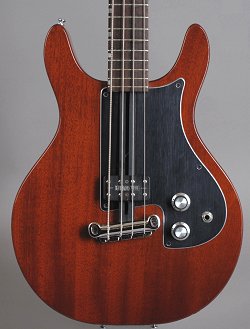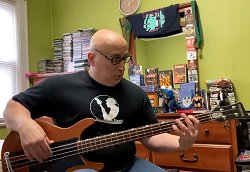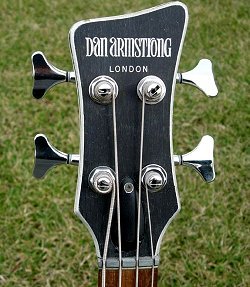

|
For the origin and the story of the Dan Armstrong 'London' bass, it is recommended to first read through the guitar
section as the bass models share the very same history as their guitar brethren.
The bass instruments did have a few interesting differences than the guitar models however. While the guitar
model is a 6 string guitar with a left handed or 12 string version available as a special order, the basses were instead
produced in both short and long scale as stock versions with left handed or fretless versions available on a special
order basis. Known as the 342 model, this is the short scale bass.
As can be seen at left, the bass guitars, particularly the short scale models, closely match the guitar model. In
fact, from a distance its 301/8"scale neck can easily be mistaken for its guitar
counterpart unless one counts the number of tuning pegs.
|
Seen here at left and right, and like the early Dan Armstrong acrylic bass models, these instruments did not employ a
selector switch. Notice the Dan Armstrong strings and literature nearby.
Like the acrylic bass models, the cutaways are right at the 24th fret. At right, and like the guitar model, the black
and brushed aluminum silver volume and tone control knobs are larger than on most instruments.
These instruments feature a bridge/tailpiece that's somewhat designed after an early Gibson 'wraparound bar' like those
seen on a Les Paul junior from that era. At right, small worm screws can be seen that help with intonation.
Unlike the guitar models, the bass features 24 frets. Like the guitar models, the bass also features a set in neck.
At left, the Dan Armstrong lettering on the headstock is the same type that would also adorn Dan's effects units. The lettering would
eventually become an icon for any and all products Dan created. At right, the 'Gumby' shaped headstock is unique to these instruments.
Notice the 'Made in United Kingdom' sticker, as well as another which is labeled 000481. Its meaning is unknown.
At left and right, the 342 model is photographed with its case as well as a set of Dan Armstrong strings and literature on the London
series instruments which can be viewed in the brochures section of this site.
At left, a Dan Armstrong 343 model that was originally listed with several errors which I'll cover momentarily. But first, in the
enlarged view, notice a routed portion in the body where the ball-end of the
strings anchor to the tailpiece. I don't know if this was a factory routing or one after the fact, but I suspect the latter as I've never
seen, nor ever heard of such a feature like this in the body before.
At right, is where some of the errors begin. Error #1 and as seen on the
Reverb
site, this bass is listed as a '342' model. But factory literature (seen in the Brochures section of this site) lists this bass as the
'343' long scale model.
Error #2 is the number of frets. The Reverb listing states that this bass has 24 frets. But as can be seen (as well
as counted) in the enlarged view, this bass only sports 19 such frets. Not surprisingly, the factory literature confirms that these '343'
long scale basses feature 19 frets. My guess is that the seller quickly looked at the factory literature, and saw the first bass that was
listed (which was the 342 short scale bass) - and incorrectly took the model number and number of frets shown, then applied this data
to his auction.
Above left and right, a closer view of the body. On the right, and in the enlarged view, notice a few screw holes as apparently several
different locations were used for strap pegs.
At left, this headstock has a stock, but different, truss rod cover. Though totally stock, the usual black coating normally seen on these
covers has been removed. On the right, Schaller tuners were stock on all the London instruments.
At left, another long scale Dan Armstrong London bass. Notice how far back the bridge/tailpiece is when compared to the short scale bass
shown at the top of this page. On the 342 model, the tailpiece unit is located next to the tone control, whereas on these long scale models
the tailpiece is located way at the bottom of the body for intonation purposes. Notice too, a large anodized aluminum scratchplate protects
much of the finish while simultaneously providing excellent shielding capabilities for the electronics. At right, the back of the body
reveals a nice grain in the wood.
At left, the 'Gumby' shaped headstock features a unique 'blister' or 'teardrop' shaped truss rod cover that's secured in place using a
single screw. The polished aluminum nut and a zero fret stands out in sharp contrast to the black anodized aluminum face of the
headstock. At right, Schaller tuners adorn the headstocks of all the London basses.
At left and right, another long scale bass. I had to marvel at the wood grain on both the front and back.

|
At left, Tony Senatore plays a Dan Armstrong London bass
he recently acquired. At the time of this writing, and, because he bought it used - it needs a good setup and perhaps a fix here or there. Tony goes on to state
"I just got the bass. Disregard the noise and hum, as I have determined that it only happens in this room with this amp."
"The pickup does say Dan Armstrong, so I imagine that it's original. I've not taken any measurements with a meter, but the pickup is not as hot as I
thought. On the other hand, it seems far from the strings, and this has to factor in."
|
"I am not sure if adjusting the pole pieces will help, but they can be adjusted.
The intonation above the 12th fret is not good. I know that it (intonation) can be done with non adjustable bridges like this. My bet is the
shop that sold it had no idea how to intonate. I love the thick mahogany body and set neck."
Later Tony wrote in stating "I called Kent Armstrong as I have been dealing with him since 2005 - and spoke to him many times, but had never met him. He told me to
bring the bass to him, and he promised that when he was through, it would be perfect. I drove 4 hours from NJ to his home in Vermont. Within minutes, he knew what
my problem was, but first, he wanted to check a few things.
He took some electrical measurements, and noted that the low impedance transformer was in place. Everything was good - he even pointed out the serial number that he
stamped in the control cavity years ago. As it turns out, the problem was simple, yet complex. Kent said that the pickup was too far from the strings. As you know, the
pickup travels up and down via a route in the body. On my particular bass - whoever did the routing made it too deep! As a result, there was simply no way to raise the
pickup - thus, a simple problem becomes difficult. Kent devised his own special method to mount the pickup on the track to get it closer to the strings. He was running
downstairs to his shop, then upstairs, back and forth for at least 2 hours. In the end, the bass was better than ever. Unbelievably loud - pure perfection."
Seen above, a later model Dan Armstrong London bass. This one is a very late model in that it not only sports the
later body style, but the headstock does not feature the 'London' stamp on it. As can be seen, and especially
noticeable in the middle photo, this bass is the long scale version. Notice how the bridge/tailpiece is near the very
bottom of the instrument which allows for a greater distance that the sliding pickup can travel, thus providing a
greater amount of tonal qualities over the short scale version.
As seen upper left, and as mentioned above, this bass does not sport the 'London' name on the headstock. According
to Tony Pitt and Kent Armstrong, this is due to the fact that in the latter days of production Dan wanted to move
all operations to Germany in an attempt to avoid the rising costs of production in England. Since instruments were
still being produced, and, since nobody knew if, or when the business would relocate to Germany, it was decided to
play it safe and drop the 'London' name - at least for the duration. At upper right, the backside of the headstock
with its Schaller tuners.
Above left and right, a 1974 Dan Armstrong Prototype Bass owned & used by Bill Wyman on several performances, such as the Rolling Stones' 1975 performance
on a flat-bed truck in New York City, the Rolling Stones 1975-76 tour and Wyman's 1981 Top Of The Pops performance of his hit single, "(Si Si) Je Suis Un Rock Star -
translated, it means (If so) I'm a Rock Star.
At left, Wyman's
stock
short scale model. At right, the very same bass after the custom work. It's essentially the same bass with a gold finish and matching gold
scratchplate. Most peculiar is a strap peg which is located on the (pardon the pun) bass side of the body just about dead center. One of the
two strap pegs on the bottom of the instrument is missing and I suspect it may be the one used for the aforementioned center pickup. The
placement of this 'center body' strap peg may seem odd at first until one realizes how Wyman holds his bass when playing it live, which is
always in a more vertical position - so maybe his strap anchors at that point. Notice, as usual for Wyman, is yet another strap peg on the
lower cutaway horn. So there's no lack of strap attachment options on this bass.
Like the guitar models, the later model basses began to arrive in different colors. According to Craig Buzzart, the
west coast distributor of these instruments "It didn't matter if it was the guitar or the bass models
but near the end days, the instruments started to arrive in different & random colors. A dealer often didn't know what
color he was going to get next." One can only assume that Dan wanted to try to stimulate sales a little further
by offering different colors.

|
Although the newer body style and white finish definitely clarifies this as a later model instrument, as can be seen here, it nevertheless
sports the 'London' name on the headstock. Towared the end of production the London name was dropped, making this a later model, but not one of the latest.
Notice the aluminum nut and zero fret as well as the machining of the aluminum veneer on the headstock. The
fine machining is most noticeable in the enlarged view.
Unlike the acrylic Dan Armstrong instruments, the headstock design did not allow for direct string pull from the nut
to the tuners as is especially noticeable in the outer (E&G) strings.
|
At left and right, another later bass which features an interesting transparent green tint to it. Being the body is the later style, coupled with
such colors would seem to support Craig Buzzart's statement above. While there are no photos of the area, I find it interesting that there is only
one strap peg that I can see on the bottom of this bass. Even more interesting, the one that's there is placed dead center. I can't help but wonder
if it shipped that way or not, but am guessing not. At right, in the enlarged view, notice what looks like a repaired break in the neck near the heel.
Upper left, the alumminum nut is better seen as is the headstock veneer, (or cap). At right, notice how polished the nut is. Notice too, a different truss
rod cover than what these instruments shipped with. In the enlarged view you will notice that, like the original truss rod cover, this
replacement cover has only one screw is holding it in place. Suggesting the original screw hole was used.
continue
menu
Names and images are TMand © Dan Armstrong / Ampeg. All rights reserved.
All other names and images are TMand © of their respective owners. All rights reserved.
|
| |

